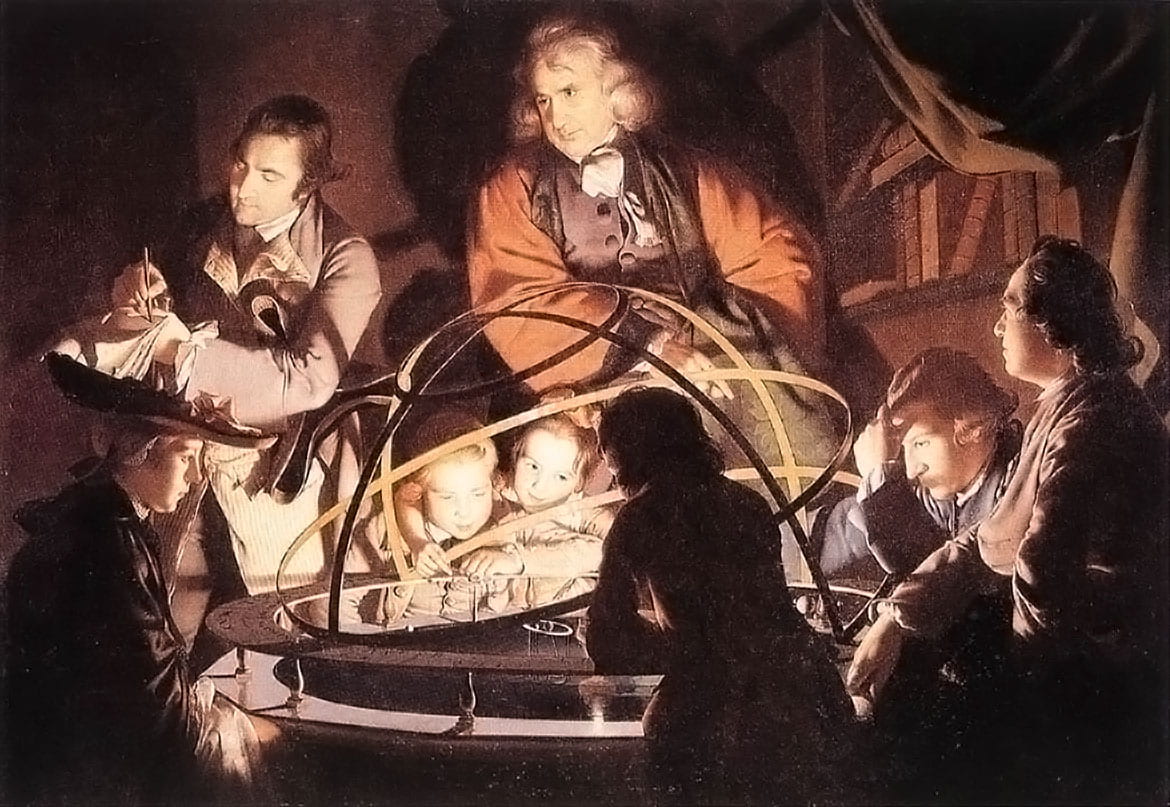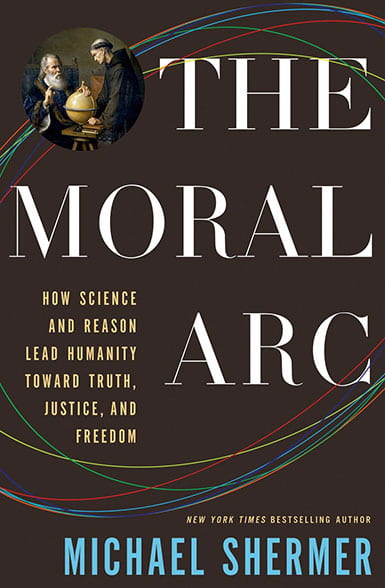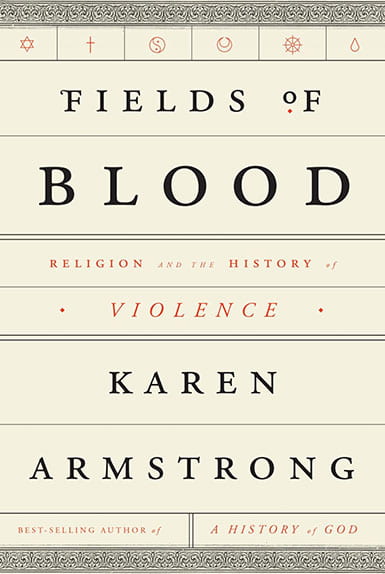
In Review
What Contributes to Moral Progress?
A Philosopher Lecturing with a Mechanical Planetary, oil on canvas, by Joseph Wright of Derby (1766). Wikimedia Commons, CC-PD
By Bradley Shingleton
The question of whether religion, on the whole, is socially benevolent or malignant has drawn increasing attention. When phrased this way, the question is obviously simplistic, binary, and abstract, but many thoughtful people continue to pose it, urgently, in light of contemporary events. Two recent books, The Moral Arc by Michael Shermer and Fields of Blood by Karen Armstrong, wrestle with the linkages among religion, violence, and moral progress. Shermer’s book deals with them indirectly, while Armstrong’s engages them head-on, and these two works yield contrasting answers.
The Moral Arc approaches the question of religion’s social beneficence in the context of Shermer’s broader argument that science and reason are the primary drivers of what he considers to be moral progress. In his view, the empirically based rationality of science trumps the obscurantism of religion when one considers the course of social progress in the post-Enlightenment era. While Shermer foregoes a frontal assault on religion à la Dawkins and Hitchens, an inescapable implication of his argument is that religion has contributed considerably less than science to the improvement of the human condition, and, worse, it lacks the resources to assist the advance of “the moral arc.” Shermer admits that religions have sporadically contributed to social betterment, but more often they have allied themselves with morally just causes only belatedly. This is not surprising in his view; he broadly claims that religions cannot be a source of moral progress, finding them to be inherently “sclerotic” and morally constricted. In a word, they fail to embrace the “modern Enlightenment goal of broadening and redefining the parameters of moral consideration” (152).
In Shermer’s view, we live in the most moral period in the history of our species, due to improvements in governance, health and longevity, and economic prosperity and to declines in violence, warfare, and crime. Indeed, much of Shermer’s data is concerned with the incidence of violence, the relative decline of which is, for him, persuasive evidence of the ability of rational approaches to reduce pathological behavior. The implication of Shermer’s meliorist argument is that violence is not intrinsic to human behavior but is essentially irrational and fostered by ignorance.
Shermer claims that rationality, at least as he defines it, is without presupposition and is universal because of its abstract character (21). Shermer sees the capacity for abstract reasoning as foundational for morality as well (22), arguing that morality should be non-perspectival and categorical, not rooted and particular. Shermer’s justification for this position is based on evolution, which required altruistic behavior for survival, became implanted in the neural architecture of humans, and generated a “logic of moral emotions” (40). These inherited characteristics, allied with Enlightenment rationalism, have made for an expanding moral arc. Based on these rationalist premises, Shermer proposes that the “goal of a science-based morality should be to construct a set of provisional moral precepts that are true for most people in most circumstances most of the time—as assessed by empirical inquiry and rational analysis” (180).
Shermer elaborates this in a “rational decalogue,” consisting of ten principles that are purged of any theistic or religious references (180–185). They include the Ask-First Principle (“to find out whether an action is right or wrong, ask first”), the Happiness Principle (“always seek happiness with someone else’s happiness in mind”), and the Rational Principle (“try to find rational reasons for your moral actions that are not self-justifications or rationalizations by consulting others first”). These are appealing precepts, but much depends on their interpretation. Happiness, for example, is a slippery notion. One person may conceive of it in material terms, another in nonmaterial terms; one individually, another collectively. Shermer deals with this by proposing a principle of interchangeable perspectives, classically expressed in versions of the Golden Rule. But this does not adequately address the tension between individual well-being and collective progress that inheres in the image of a moral arc.
Shermer suggests that moral progress, which he defines as “the improvement in the survival and flourishing of sentient beings” (12), has proceeded apace with technical progress. In his reading, societies have become increasingly moral: more democratic, more materially prosperous, healthier, and less violent. Shermer sees all of these diverse developments promoted by rational and scientific attitudes, specifically, empirical methods of trial and error, hypothesis and demonstration, verifiability and falsifiability. Scientific rationalism has, through its demonstrable and rationally accessible methods, pioneered developments in social and political arrangements that are less violent and more humane than premodern ones.
Shermer argues his case vigorously, marshaling empirical evidence, often in graphic form, drawn mostly from the social sciences. He strikes an attractively optimistic tone. The book is quite lengthy and at times shifts abruptly from arguments to expositions of empirical research. Occasionally, he is prone to rigid dismissals of religious faith, such as his claim that one path to a more moral world is “to get people to quit believing in absurdities” (7). Overall, however, Shermer is an amiable exponent of his position.

The Moral Arc
Nevertheless, The Moral Arc, and the argument it advances, is less than satisfying in several ways. First, Shermer’s moral arc is a trajectory of unequivocal progress, with only a nod to its attendant costs. He fails to do justice to the reality that virtually every scientific and social development entails certain burdens, and these are often unequally distributed. Technical innovations have been accompanied by unwelcome consequences: environmental degradation, depletion of natural resources, materialism, consumerism, cultural dislocation, and the displacement of cultural values and practices. For many, the instrumental character of technical advances raises questions about their purposefulness: what are the various goals that science and technology do and should pursue? And what of their impacts on other orienting values? Clearly science and technology affect what Albert Borgmann calls “focal practices” by scattering our attention and cluttering our surroundings.1 This is not to doubt that science has contributed greatly to human well-being, but rather to acknowledge that this is not the whole story. Technical achievements are indeed beneficial, but not unambiguously so.
Other questions loom as well. Who controls and supervises the course of technical development? What criteria govern it? Expediency, utility, availability? Should it—can it—be controlled at all? Shermer’s view is premised on a utilitarian calculus of social benefit, with all the attendant problems of how to weight conflicting individual and collective needs and interests, but he devotes little space in this long book to questions of the political control of science and technology. How are public resources to be allocated among competing needs? How are conflicting interests (individual/social, national/global, public/private) to be reconciled? Who determines whether the environmental and social costs of technical development are acceptable? These and other difficult questions of fairness and distributive justice belie the idea that reason and science are value-neutral and incontrovertible. Scientific developments entail costs and compromises among competing goods, and science itself does not, and cannot, supply the values necessary to address those conflicts because it is a realm of means and not ends.
Moreover, while empirical observation and rational methods obviously contribute to beneficent social development, focusing on just these practices excludes much else of human significance. As Keith Ward has noted, a “tough-minded scientific perspective . . . removes virtually all historical, political, ethical, aesthetic, personal, legal, and philosophical topics from the area of knowledge and deposits them in the dustbin of personal opinion or even of illusion.”2 Though Shermer acknowledges, in general, that these considerations are not irrelevant, they play no practical role in the version of public rationality he endorses.
Also questionable is the book’s correlation of scientific development and moral progress. By defining moral progress in terms of human flourishing, Shermer relies on a notion—flourishing—that in contemporary usage is somewhat of a cipher. Is it to be understood in terms of physical well-being, virtue, spiritual refinement, all of these, or something else? Many would hold that moral progress has to do with more than material well-being or an adherence to rational approaches to problem solving; it also has to do with the cultivation of intangible values and virtues.
Further, moral development can be halting and subject to regression. Shermer devotes one chapter to moral regress, largely concerned with the experience of Nazism, and he concludes that by understanding the conditions and dispositions that produce evil, “we can quell evil and keep it in check through the social tools and political technologies we now know how to employ to the betterment of humanity” (332). Further, he asserts that Nazi ideology was based on factual errors about, for example, the nature of Judaism and the role of Jews in German society. This behaviorist reading suggests that Nazism was a pernicious episode of moral regress which would have been corrigible if subjected to the necessary factual corrections. In the face of the systematic slaughter of millions of innocent people, this seems exceedingly inadequate.
In Shermer’s view, which I find disappointing, religions are essentially incapable of generating moral progress because they are resistant to rational criticism and lack the Enlightenment’s commitment to rational justification and its preference for autonomy over authority. One would expect that a restatement of the new atheist critiques of Dawkins, Harris, and others would no longer be considered sufficient, and that Shermer would engage with some of the thoughtful critiques of them. At the very least, I would hope that an author who edits a magazine titled Skeptic would direct some skepticism toward his own presuppositions. Now, as always, religions require sound and searching critiques, but this book fails to deliver one.
A more substantial contribution to the debate about the connection between religion and violence is Karen Armstrong’s Fields of Blood. In many ways, this work is as accomplished as her previous books: informed, eloquent, and provocative. Her thesis, broadly put, is that religions have reflected the structural violence of the societies in which they appear. The nature of violence has changed alongside the evolution of societies. Religions have, over time, both justified violence and contributed to its reduction. Some have suggested that Armstrong lets religion off too easily,3 but that criticism seems too casual and simple in light of her careful sifting of a considerable amount of historical evidence.
In Armstrong’s view, much consideration of the religion/violence question suffers from a reductionist notion of religion. Western understandings of it are “idiosyncratic and eccentric,” she contends here, “complicat[ing] any attempt to pronounce on religion’s propensity to violence” (4). In the West, religion is seen as a coherent system of obligatory, theistically oriented beliefs, institutions, and rituals in private, sequestered, communal realms. This wrenches religion from its cultural, social, and historical context, allowing it to be scapegoated for inspiring, through its texts and practices, the violence that is rooted in civilization itself.
In Armstrong’s account, the development of religions has been closely tied to developments in societies and civilizations; indeed, these spheres have continually interacted and influenced each other. Civilization is built, as she sees it, on violence. Only when a sufficient surplus of food and other material necessities existed could aristocratic elites arise. They alone had the sufficient leisure to develop higher arts. Armstrong suggests that civilization is historically parasitic, since it is dependent on continuing acts of expropriation that persist through evolutions from hunting-gathering societies to agriculture, industrialization, and technological post-industrialization.

Fields of Blood
A key concept in Armstrong’s interpretation is “structural violence.” By this she means the violent practices of self-perpetuating, institutional arrangements that force “people to live in such wretchedness and subjugation that they are unable to better their lot” (13). Armstrong sees this kind of violence as inherent in agrarian societies and less evident in—though not absent from—later stages of society. Moreover, religion and politics were deeply intertwined in premodern societies such that political arrangements were typically sacralized. Religion absorbed violence into its own structures and practices, from its political and cultural environment, and inevitably assisted in maintaining those structures. Fields of Blood presents copious historical evidence that organized, structural violence of this kind was driven by geographical, political, and cultural forces. A paradigmatic figure for Armstrong is the Indian emperor Aśoka (268–232 BCE), the architect of a vast empire forged through brutal military conquest. He later came to revile the sufferings he and his armies inflicted, and, thus, he exemplifies the moral ambiguity of social order. Aśoka represents what Armstrong refers to as the “dilemma of civilization itself” in that it relies upon the corrupting necessity of violence.
Armstrong’s historical interpretation of the relationship between religion and civilization, which ranges across religious traditions and focuses extensively on the Abrahamic faiths, suggests that violence primarily proceeds from the material circumstances and contingencies of social and political existence. Religion, as a cultural phenomenon, shares in this historical legacy of violence, both sanctioning and condemning it. To the extent that religion and politics are culturally entangled and religion is enlisted to endorse the various forms of structural violence, it would seem that religion increases the potential for violence. This would tend to support Shermer’s claim that secularism’s separation of the two realms has contributed to an overall decline in violence. Armstrong would likely think this separation is unmanageable over the long haul because of a deep human need for finding meaning in various spheres of life, including the political. In any event, she sees violence as an essentially human, cultural phenomenon, not as the consequence of irrationality or dogmatism. Politics, ethnic grievances, economic dislocation—all of these factors and others can also inflame animosities and prompt violence. So Armstrong argues for a broader notion of the causality of violence, one in which religion has played (and plays) a significant but hardly exclusive role.
Along similar, more theoretical lines, Wolfgang Huber (following Hans Kippenberg) proposes that the relationship between religion and violence be seen as contingent, dependent on historical circumstances and “neither necessary nor impossible.”4 Religion has to deal with reality as a whole, Huber argues, and reality is often violent.
In this sense, Fields of Blood can be read as a history of the contingent relationship between religion and violence. Religion has been, and will continue to be, intimately involved with, and affected by, social and political arrangements with their implicit and explicit capacities for violence. Religion has been and will continue to be enlisted in support of the proximate causes of the day and it—like civilization itself—has a mixed legacy. Armstrong suggests that if we “meaning-seeking creatures” confront the legacies of barbarism in our states as well as our faiths, and if we see these histories as contrary to the deep, abiding prescriptions against violence in the world’s religions, we might challenge the exceptionalist thinking that leads to devastating cycles of brutality.
The question remains whether such a subtle analysis as Armstrong’s will resonate in the din of contemporary discussions about religion and violence, given the influence of public media in framing such discussions. All too often religion is used loosely and adjectivally as a convenient kind of shorthand, in a way that often implies a causal connection between religious identity and violence. Amartya Sen has described this as the use of religion as identity marker, and he argues that it is damaging to understandings of both identity and religion. Armstrong’s book is particularly valuable as a corrective to these same distorted associations that Sen has critiqued.5
Tillich contended that religions have vertical and horizontal dimensions. Shermer’s notion of religion in The Moral Arc is basically concerned with its horizontal, social aspect and its individual therapeutic consolations. Karen Armstrong treats religion in both dimensions, acutely analyzing how the entanglements of specific historical religions with political and social structures have frequently led to their instrumentalization and manipulation. Embodied in human traditions and institutions, susceptible to human proclivities to violence, religion is challenged by its history. To her credit, Armstrong does not absolve religion of responsibility for its ambiguous legacy by blaming it on the abuse and misinterpretation of religious traditions by some adherents. Though this has certainly occurred, something intrinsic to religious traditions seems to figure as well, a defensive impulse linked to the protection and transmission of matters of sacred significance. This deep significance, it would seem, can inspire such unrelenting allegiance that believers feel compelled to defend it with acts of violence. John Bowker has called this the “paradox of religious urgency,”6 by which he means that religion is capable of evil because it is so intensively concerned with good.
Yet religion is also capable, as Armstrong reminds us, of inviting transcendence and transformation. These redemptive capacities can justify religion despite its violent excesses. The challenge is to keep in view both religion’s negative and affirmative possibilities. Religion’s historical entanglements with violence and repressions do not, contra Shermer, nullify its moral legitimacy and reduce it to a vestige of prescientific attitudes. Rather, pro Armstrong, religion’s capacity for preserving humanizing, transformative beliefs and practices in the midst of a violent world can be cause for hope for its future.
Notes:
- Albert Borgmann, Technology and the Character of Contemporary Life (University of Chicago Press, 1984), 208.
- Keith Ward, The Big Questions in Science and Religion (Templeton Foundation Press, 2008), 173.
- See, for example, James Fallows’s review of the book in The New York Times, December 10, 2014.
- Wolfgang Huber, “Religion and Violence in a Globalized World,” Bulletin of the German Historical Institute 47 (Fall 2010): 63.
- Amartya Sen, Identity and Violence: The Illusion of Destiny (W.W. Norton, 2006).
- For one work where Bowker explains the “paradox of religious urgency,” see John W. Bowker, introduction to Conflict and Reconciliation: The Contribution of Religions (Key Publishing, 2008), 10.
Bradley Shingleton, a graduate of Harvard Divinity School (MTS ’78) and Duke University Law School (JD ’82), practices international law in Washington, DC. His publications include The Global Ethic and Law (Nomes/Bloomsbury, 2015).
Please follow our Commentary Guidelines when engaging in discussion on this site.

